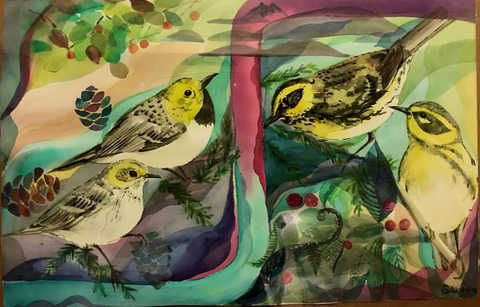Congratulations to Silu Wang, who has published her first paper on the Setophaga townsendi / Setophaga occidentalis hybrid zone, showing surprising stability of the zone over a period of 25 years.
Silu and I are grateful to coauthor Sievert Rohwer, who collaborated on this project and allowed access to his many samples of warbler tissues from the 1987-1994 time period. We also thank coauthor Kira Delmore for her contributions to the genomic analysis.
Here is Silu’s painting inspired by the hybrid zone:

The full citation:
Wang, S., S. Rohwer, K. Delmore, and D.E. Irwin. Cross-decades stability of an avian hybrid zone. Journal of Evolutionary Biology 32: 1242-1251. Link
The Abstract:
Hybrid zones are particularly valuable for understanding the evolution of partial reproductive isolation between differentiated populations. An increasing number of hybrid zones have been inferred to move over time, but in most such cases zone movement has not been tested with long‐term genomic data. The hybrid zone between Townsend’s Warblers (Setophaga townsendi) and Hermit Warblers (S. occidentalis) in the Washington Cascades was previously inferred to be moving from northern S. townsendi southwards towards S. occidentalis, based on plumage and behavioural patterns as well as a 2000‐km genetic wake of hermit mitochondrial DNA (mtDNA) in coastal Townsend’s Warblers. We directly tested whether hybrid zone position has changed over 2–3 decades by tracking plumage, mtDNA and nuclear genomic variation across the hybrid zone over two sampling periods (1987–94 and 2015–16). Surprisingly, there was no significant movement in genomic or plumage cline centres between the two time periods. Plumage cline widths were narrower than expected by neutral diffusion, consistent with a ‘tension zone’ model, in which selection against hybrids is balanced by movement of parental forms into the zone. Our results indicate that this hybrid zone is either stable in its location or moving at a rate that is not detectable over 2–3 decades. Despite considerable gene flow, the stable clines in multiple phenotypic and genotypic characters over decades suggest evolutionary stability of this young pair of sister species, allowing divergence to continue. We propose a novel biogeographic scenario to explain these patterns: rather than the hybrid zone having moved thousands of kilometres to its current position, inland Townsend’s met coastal Hermit Warbler populations along a broad front of the British Columbia and Alaska coast and hybridization led to replacement of the Hermit Warbler plumage with Townsend’s Warbler plumage patterns along this coastline. Hence, hybrid zones along British Columbia and Alaska moved only a short distance from the inland to the coast, whereas the Hermit Warbler phenotype appears stable in Washington and further south. This case provides an example of the complex biogeographic processes that have led to the distribution of current phenotypes within and among closely related species.
